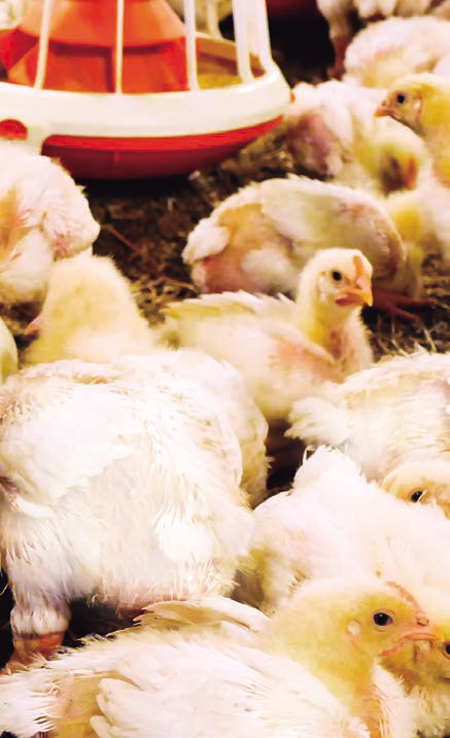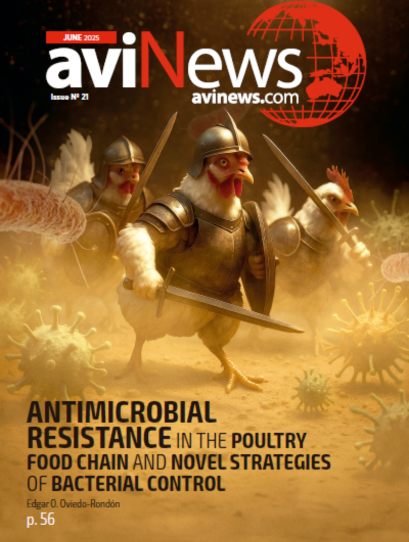Infectious bursal disease virus (IBDV) is a serious disease in broiler flocks. Maternal immunity can be achieved through vaccinating the breeder flock. However, that’s no guarantee for complete immunity of the offspring. Usually also proper vaccination of the broiler flock is needed. In order to let this be successful, monitoring field strains is essential.
By Daral J. Jackwood, PhD
Professor
The Ohio State University, Columbus, OH USA
More than 60 years of research and experience have made it clear that infectious bursal disease in broilers is here to stay, and that unless it’s managed, considerable losses can occur.
Vaccines are the best tool we have to combat infectious bursal disease virus (IBDV), but too often success is only marginal unless we understand the evolving nature of this pathogen, monitor carefully for changes and adjust the vaccine protocol accordingly.
The strains of IBDV circulating in commercial broiler flocks today are very different from the ones that were identified 6 decades ago. It wasn’t until the 1980s we realized there was more than one type of IBDV.
IBDV’s changing nature
The most common reason for changes in the strains of IBDV is antigenic drift, which is due to random, minor genetic mutations. The changing nature of IBDV is due in part to its genome. It’s a double-stranded RNA virus, which is more likely than a virus with a DNA genome to have genetic mutations.
These mutations enable more recently evolved IBDVs to outcompete older or ancestral IBDV strains. They may evade the neutralizing antibodies produced after IBDV vaccination, or they may replicate faster or be transmitted more easily.
The rate that IBDV changes its antigenic structure is slow compared to some other RNA viruses, such as infectious bronchitis virus (IBV), but given enough time and selection pressure, IBDV will mutate and circumvent our vaccination efforts unless we make necessary adjustments.
Potential for permanent damage
IBDV is an immunosuppressive pathogen. It’s especially damaging if chicks are infected during the first 3 weeks of life. That’s because IBDV infects immature B cells in the bursa of Fabricius. If these B cells in young birds are eliminated by infection, not enough will go on to mature into antibody-producing plasma cells. The result is permanent damage to the bird’s immune system, which sets the stage for costly secondary infections. That’s why it’s critically important to protect young broilers from infection.
By approximately 3 weeks of age, many of the B cells have matured, and the potential for permanent immune suppression has thus passed. However, it’s important to understand that infections after 3 weeks of age can still cause a temporary disruption in immune function. While not as profound as from early infections, temporary dips in immunity following late IBDV infections can be consequential if other infections (e.g., IBV, Escherichia coli) occur in that window.
When MABs aren’t pulling their weight
The best approach for protecting young broilers against IBDV is to hyperimmunize the breeder flocks so they pass IBDV immunity on to progeny. The best way to assess how well the breeder flock was vaccinated against IBDV is by checking the titers of maternal antibodies (MABs) in 3- to 4-day-old broilers.
Titers indicate the quantity of MABs, but it’s also important to check the ability of these antibodies to protect the chicks. This can be determined by assessing the age at which the broiler chicks are getting infected with IBDV. If MAB titers are high but chicks are still being infected at less than 3 weeks of age, that’s an indication that maternal immunity is failing to protect birds from immunosuppressive disease.
What’s the most likely culprit for this failure? It’s antigenic drift. In other words, the MABs produced by a breeder-flock vaccine are antigenically unrelated to the field virus challenging chicks. The remedy is an adjustment in the vaccines used in breeder flocks, which requires accurately identifying the strains of IBDV breaking through MABs. These adjustments can involve careful selection among commercially available killed vaccines and sometimes the inclusion of custom-made autogenous or even subunit vaccines.
According to a recent survey,1 the AL2 family of variants constituted half of all IBDVs detected in an analysis of US broilers flocks, but there is also considerable diversity in the other half of circulating variants. This underscores the need for identifying IBDV field strains by location.
This is best accomplished by collecting bursal samples for molecular diagnostic testing. Specifically, reverse transcription polymerase chain reaction and nucleotide sequencing enable us to quickly verify the identity of the problematic IBDV strain and compare it to vaccine strains.
Bridging passive and active IBDV immunity
MAB protection from IBDV the first few weeks of life is critically important, but it may not be enough on its own due in part to changing industry trends. In the past, antibiotics were used to help control secondary infections that erupted when maternal immunity waned and IBDV infected the broiler flock.
Without antibiotics as a tool, even temporary immune suppression can create disease opportunities, so it has become essential to control immune suppression caused by IBDV at any age. When maternal antibodies become critically low, the bird is susceptible to infection, so vaccinating broiler chicks to produce active immunity is more important now than ever.
Ideally, active immunity from vaccination will protect chicks before maternal immunity declines. However, active immunity takes time to develop, and if it doesn’t initiate immunity quickly enough, there may be a window of susceptibility when broilers are vulnerable to IBDV infection. Closing this window or at least narrowing the gap between the time when MABs decline and active immunity kicks in has been a challenge.
Initiating active immunity
Active immunity can be induced by several different types of vaccines: live-attenuated, HVT-IBDV recombinants and immune complex. All these vaccine types can be effective tools — if they are used correctly. Some even provide cross-protection against related antigenic strains of IBDV. But here again, I’ll emphasize that it takes time for the bird to respond with an active immune response strong enough to be protective.
Exactly how long it takes for a protective immune response to develop can be affected by many variables. Some variables even involve the bird’s developing immune system. The three vaccine types work differently, so it’s important to understand their respective strengths and limitations and how this all factors into the particular field situation and the company’s goals.
Depending on the window of field challenge and one’s goals and tolerances, any protection gaps between maternal immunity and active immunity are best addressed by either the breeder program, the broiler program or often both.
Fortunately, we have excellent tools to quickly diagnose the timing and antigenic nature of our challenge viruses. Molecular technology can also help us make more informed and targeted vaccine decisions. Technology like this is going to help us in the fight to manage IBDV in the future. The era of “no antibiotics ever” demands it.
1 Cookson K, et al. A survey of wild type IBDV isolated from broiler flocks in the United States since 2014. 2020 International Poultry Scientific Forum, Atlanta, Georgia.










